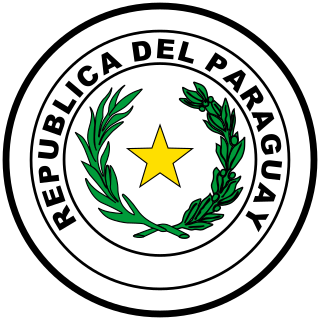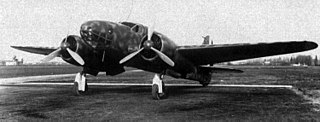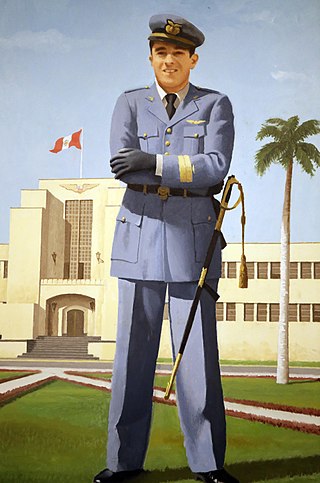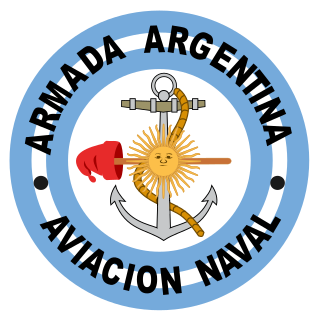
The Armed forces of Paraguay consist of the Paraguayan army, navy and air force.

The Peruvian Armed Forces are the military services of Peru, comprising independent Army, Navy and Air Force components. Their primary mission is to safeguard the country's independence, sovereignty and territorial integrity against any threat. As a secondary mission they participate in economic and social development as well as in civil defense tasks.

The Peruvian Air Force is the branch of the Peruvian Armed Forces tasked with defending the nation and its interests through the use of air power. Additional missions include assistance in safeguarding internal security, conducting disaster relief operations and participating in international peacekeeping operations.

The Embraer EMB 312 Tucano is a low-wing, tandem-seat, single-turboprop, basic trainer with counter-insurgency capability that was developed in Brazil. The Brazilian Air Force sponsored the EMB-312 project at the end of 1978. Design and development work began in 1979 on a low-cost, relatively simple new basic trainer with innovative features which eventually became the international standard for basic training aircraft. The prototype first flew in 1980, and initial production units were delivered in 1983.

The Colombian Air Force is the air force of the Republic of Colombia. The Colombian Air Force is one of the three institutions of the Military Forces of Colombia charged, according to the 1991 Constitution, working to exercise and maintain control of Colombia's airspace and to defend its sovereignty, territorial integrity and constitutional order. It is one of the largest air forces in the Americas and has increased its activity due to important roles in the fight against narco-terrorism. Its main force includes 21 IAI Kfirs as defense fighters and 14 Cessna A-37 Dragonfly plus 24 Embraer 314 Super Tucano for counterinsurgency.

The Spanish Republican Air Force was the air arm of the Armed Forces of the Second Spanish Republic, the legally established government of Spain between 1931 and 1939.

The Caproni Ca.310 Libeccio was an Italian monoplane, twin-engine reconnaissance aircraft used in World War II. Derived from the similar Ca.309, it had its combat debut during the Spanish Civil War and took part in the earlier phases of World War II in Libya. Some were used in attack groups as a temporary replacement for the unsatisfactory Breda Ba.65. The last Ca.310 was retired by the Italian Air Force in 1948.

Alfredo Fernández Martínez better known as Alfredo Mayo was a Spanish actor.

The Caproni Bergamaschi AP.1 was an Italian monoplane attack aircraft designed by Cesare Pallavicino, coming from the Breda firm.

José Abelardo Quiñones Gonzáles was a Peruvian military aviator and posthumously became a national hero for his actions at the Battle of Zarumilla during the Ecuadorian–Peruvian War of 1941.

The Caproni Ca.135 was an Italian medium bomber designed in Bergamo in Italy by Cesare Pallavicino. It flew for the first time in 1935, and entered service with the Peruvian Air Force in 1937, and with the Regia Aeronautica in January 1938.

The Caproni Ca.100 was the standard trainer aircraft of the Regia Aeronautica in the 1930s. Large numbers of this tandem, two-seat, biplane were built, powered by different engines.

The Caproni Vizzola F.5 was an Italian fighter aircraft that was built by Caproni. It was a single-seat, low-wing cantilever monoplane with retractable landing gear.

The Caproni Ca.70 was a two-seat night fighter and ground attack biplane produced in Italy in 1925. It was the only Italian aircraft designed from the outset as a night fighter.

The Caproni Ca.71, originally Ca.70L, was a two-seat biplane night fighter produced in Italy in 1927. It was derived from the Caproni Ca.70 of 1925.

The Caproni Vizzola F.6 was a World War II-era Italian fighter aircraft built by Caproni. It was a single-seat, low-wing cantilever monoplane with retractable landing gear. Only two prototypes were built, one designated F.6M and the other designated F.6Z.

The Caproni Ca.331 Raffica was an Italian aircraft built by Caproni in the early 1940s as a tactical reconnaissance aircraft/light bomber and also as a night fighter.

The Argentine Naval Aviation is the naval aviation branch of the Argentine Navy and one of its four operational commands. Argentina, along with Brazil is one of two South American countries to have operated two aircraft carriers
TNCA Series A was a utility biplane made in Mexico by Talleres Nacionales de Construcciones Aeronáuticas (TNCA).



















